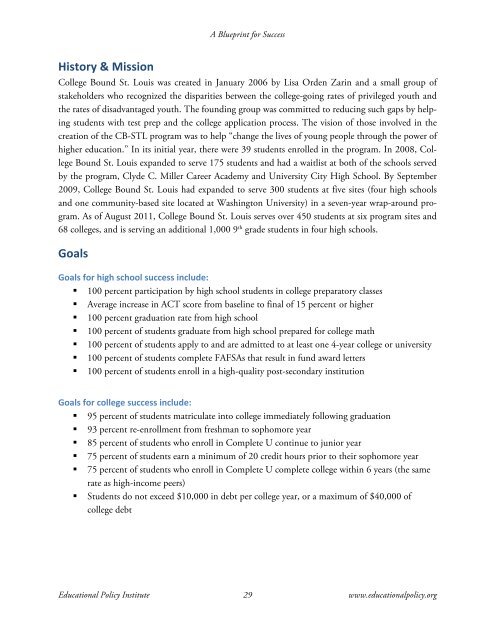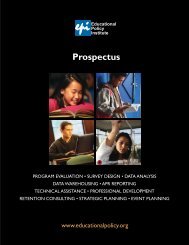A BluePrint for Success: Case Studies of Successful - Educational ...
A BluePrint for Success: Case Studies of Successful - Educational ...
A BluePrint for Success: Case Studies of Successful - Educational ...
You also want an ePaper? Increase the reach of your titles
YUMPU automatically turns print PDFs into web optimized ePapers that Google loves.
History & Mission<br />
A Blueprint <strong>for</strong> <strong>Success</strong><br />
College Bound St. Louis was created in January 2006 by Lisa Orden Zarin and a small group <strong>of</strong><br />
stakeholders who recognized the disparities between the college-going rates <strong>of</strong> privileged youth and<br />
the rates <strong>of</strong> disadvantaged youth. The founding group was committed to reducing such gaps by helping<br />
students with test prep and the college application process. The vision <strong>of</strong> those involved in the<br />
creation <strong>of</strong> the CB-STL program was to help “change the lives <strong>of</strong> young people through the power <strong>of</strong><br />
higher education.” In its initial year, there were 39 students enrolled in the program. In 2008, College<br />
Bound St. Louis expanded to serve 175 students and had a waitlist at both <strong>of</strong> the schools served<br />
by the program, Clyde C. Miller Career Academy and University City High School. By September<br />
2009, College Bound St. Louis had expanded to serve 300 students at five sites (four high schools<br />
and one community-based site located at Washington University) in a seven-year wrap-around program.<br />
As <strong>of</strong> August 2011, College Bound St. Louis serves over 450 students at six program sites and<br />
68 colleges, and is serving an additional 1,000 9 th grade students in four high schools.<br />
Goals<br />
Goals <strong>for</strong> high school success include:<br />
100 percent participation by high school students in college preparatory classes<br />
Average increase in ACT score from baseline to final <strong>of</strong> 15 percent or higher<br />
100 percent graduation rate from high school<br />
100 percent <strong>of</strong> students graduate from high school prepared <strong>for</strong> college math<br />
100 percent <strong>of</strong> students apply to and are admitted to at least one 4-year college or university<br />
100 percent <strong>of</strong> students complete FAFSAs that result in fund award letters<br />
100 percent <strong>of</strong> students enroll in a high-quality post-secondary institution<br />
Goals <strong>for</strong> college success include:<br />
95 percent <strong>of</strong> students matriculate into college immediately following graduation<br />
93 percent re-enrollment from freshman to sophomore year<br />
85 percent <strong>of</strong> students who enroll in Complete U continue to junior year<br />
75 percent <strong>of</strong> students earn a minimum <strong>of</strong> 20 credit hours prior to their sophomore year<br />
75 percent <strong>of</strong> students who enroll in Complete U complete college within 6 years (the same<br />
rate as high-income peers)<br />
Students do not exceed $10,000 in debt per college year, or a maximum <strong>of</strong> $40,000 <strong>of</strong><br />
college debt<br />
<strong>Educational</strong> Policy Institute 29 www.educationalpolicy.org




